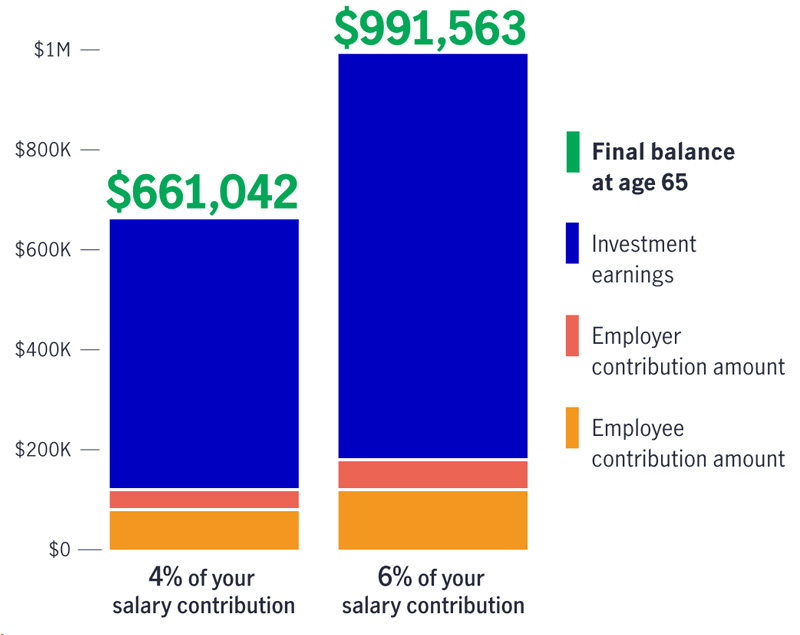.jpg)
Our Next CIO Learned Valuable Lesson While Working at Local Grocery Store
Johara Farhadieh’s journey to become Wespath’s chief investment officer is both uniquely her own and entirely relatable.
Growing up, Johara planned to become a doctor. But before she could major in pre-med, Johara went to work at her local Jewel-Osco grocery store in suburban Chicago when she was 15.
The job became more than just a job. It became a constant during what was a transitionary period in her young life. Johara proceeded to graduate high school and enroll at DePaul University in Chicago—all while she continued to clock in at the grocery store. The job also helped spark her interest in finance and investing.
When she turned 18, Johara became eligible to enroll in the 401(k) retirement plan Jewel-Osco offered its employees. A colleague explained to Johara that her employer would match a percentage of her contributions to the 401(k). Johara said she saw the employer match as free money—and took advantage of it. She also started to explore how her money was invested and her investment options.
Johara’s job at the grocery store wasn’t the only reason she graduated from DePaul with a degree in finance.
“Let’s just say I wasn’t as passionate about organic chemistry as I was about financial analysis,” said Johara, who becomes Wespath’s chief investment officer August 1.
Johara’s financial circumstances also played a factor in her decision to change majors. She worried about the cost of medical school and the fact she would need to incur significant debt to pay for it. With an undergraduate degree in finance, Johara could start her career immediately after graduation. She went to work as a senior financial analyst at Central States Pension Fund. It also meant she had to quit her job with Jewel-Osco after eight years.
“It was bittersweet to leave after so many years,” Johara said. “They were good to me.”
If Johara’s story resonates with you, below are some tips and recommendations you may find helpful related to retirement and personal finance.
Starting to Save for Retirement
“With today’s bills demanding so much of your attention, saving for longer-term goals like retirement can seem like an impossible task,” EY wrote in its Spring 2024 newsletter. “But starting to save and invest for retirement now could turn out to be the best financial decision you’ll ever make.”
This is true whether you are 25 or 45.
According to EY, one of the best things you can do is determine the percentage of your retirement contributions that your employer will match—and then try to contribute at least enough to get the full match. If you don’t, as Johara learned, you are essentially leaving free money on the table.

This chart is for illustrative purposes only. It assumes a $0 starting balance, a $50,000 annual salary, bi-weekly employee contributions of $76.92 (4% contribution) or $115.38 (6% contribution) from age 25 to age 65, and a 7% rate of return. Employer match formula is 50% up to the first 6% of pay contributed. For someone contributing 4% for 40 years, this equates to employee contributions of $80,000, employer contributions of $40,000, and investment earnings of $541,042. For someone contributing 6% over 40 years, this equates to employee contributions of $120,000, employer contributions of $60,000, and investment earnings of $811,563. Figures are based on assumptions as set out, and individual circumstances may vary. For example, the rate of return for your retirement account may be less than the rate of return used in the example. Please check with your plan sponsor to better understand the matching contribution for your account, which may be less than that used in the example.
Credit: John Hancock
EY also suggests increasing your retirement account contribution each time you receive a raise.
For additional tips, check out EY’s age-specific recommendations.
Managing Debt
Student loans and credit card debt also can make the prospect of saving for retirement daunting.
Saving Grace, a personal money management curriculum guided by Wesleyan values, shares how to pay off debt using the “snowball method.”
The snowball method is straightforward:
- List all your debts from smallest to largest. Don’t worry about the interest rate of each.
- Make the minimum payment on all your debts except the smallest one.
- Put as much extra money as you can afford toward your smallest debt until it is paid off.
After you pay off your smallest debt, repeat steps 2 and 3 for the next-smallest debt again and again until all your debt is paid off. The snowball method is designed to deliver little wins at the start of the process and motivate you to keep going.
Another option to help with managing credit cards and other debt is to work with an EY financial planner. Wespath participants and surviving spouses with account balances (as well as retired and terminated participants with account balances of at least $10,000) can speak with an EY financial planner at no additional cost by calling 1‑800‑360‑2539.1
1 Costs are included in Wespath’s operating expenses that are paid for by the funds.

